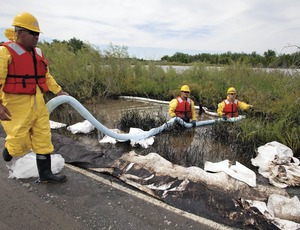
Nebraska Gov. Dave Heineman (R) must decide by early February whether to allow TransCanda Corp. to build the Keystone XL pipeline through his state. But a final federal decision on the cross-border oil sands pipeline is still several months off. A recent report on a 2011 pipeline rupture that inundated the Yellowstone River in Montana with 1,500 barrels of oil is unlikely to provide any new ammunition to opponents seeking to stop the Keystone pipeline.
Heineman received a 2,000-page report on Keystone from Nebraska's Dept. of Environmental Quality on Jan. 2. He has 30 days to make a decision on the line. DEQ concludes that the newest route avoids the pristine Sand Hills region and shallow groundwater areas. The pipeline would still cross portions of the sensitive Ogallala Aquifer, but DEQ concluded that the new route would have minimal impact. Heineman, who opposed the previous route because it crossed the Ogallala, is widely expected to approve the new route.
If the proposal makes it through the approval process to President Obama's desk, says Tony Iallonardo, a spokesman for the National Wildlife Federation, Obama "really needs to deny the permit—from a financial basis. The costs from Hurricane Sandy are too high to continue to approve pipelines like this." While environmental groups, including NWF, say they may go to court if a final decision favors the pipeline, a presidential permit, unlike a decision from a federal agency, is not subject to judicial review.
Some opponents of Keystone fear that corrosive Canadian oil sands will weaken the pipeline and make spills more likely. However, a recent report from the U.S. Pipeline and Hazardous Materials Safety Administration on the July 1, 2011, rupture of an ExxonMobil pipeline in the Yellowstone River shows that the rupture was caused by external scouring and debris from record-high floods on the river and debris, not interior damage. The steel pipe, which occasionally carries oil sands from Alberta, showed only evidence of normal interior pitting.
The report, by the engineering firm of Kiefner & Associates Inc. of Worthington, Ohio, concluded that was no evidence that "internal or external corrosion, stress-corrosion cracking, pipe manufacturing defects or mechanical damage developed in service and contributed to the failure." The 12-in. pipe was installed in 1991 using an open trench method and buried 6 to 8 ft below the river bed. Subsequent flooding eroded the pipe's covering. Since the spill, the pipe has been reinstalled using horizontal drilling deep below the river, according to the report.
The report concludes that if ExxonMobil operators had acted more quickly to close valves, they would have reduced spillage by two-thirds.

Post a comment to this article
Report Abusive Comment